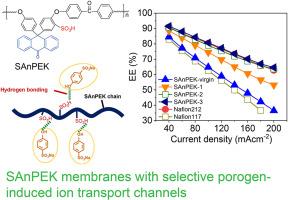High-performance SAnPEK membranes with selective porogen-induced ion transport channels for aqueous organic redox flow batteries
IF 7.9
2区 工程技术
Q1 CHEMISTRY, PHYSICAL
引用次数: 0
Abstract
Aqueous organic redox flow batteries (AORFBs) have attracted extensive attention as a promising energy storage technology, but they still face challenges in developing high-performance membranes, especially membranes with high ionic conductivity, selectivity, and excellent stability. In this work, a new strategy of selective porogen-induced ion transport channels formation is used to construct highly conductive and selective ion transport channels in low-sulfonated SAnPEK membranes. The original SAnPEK-virgin membrane exhibits a high area resistance of 0.93 Ωcm2. The SAnPEK-3 membrane, which is made by adding only 1.82 wt% of the selective porogen sodium p-hydroxybenzenesulfonate, exhibits a low area resistance of 0.257 Ωcm2, which is 37.6 % of the SAnPEK-virgin membrane and even lower than the benchmark Nafion212 membrane (0.276 Ωcm2). The SAnPEK-3 membrane also exhibits excellent selectivity and high mechanical strength (39.2 MPa). In AORFB, the SAnPEK-3 membrane shows an energy efficiency of up to 91.47 % at 40 mA cm−2, which is better than the commercial Nafion117 membrane (82.95 %) and Nafion212 membrane (90.86 %). Moreover, the SAnPEK-3 membrane shows excellent cycle stability in 9600 cycle tests. The proposed method for preparing membranes with selective porogen-induced ion transfer channels can significantly improve membrane conductivity and is easy to scale up.

高性能SAnPEK膜与选择性孔隙诱导离子传输通道的水有机氧化还原液流电池
水相有机氧化还原液流电池(AORFBs)作为一种极具潜力的储能技术受到了广泛的关注,但其在高性能膜的开发方面仍面临挑战,特别是在高离子电导率、选择性和优异稳定性方面。在本研究中,采用选择性孔隙诱导离子传输通道形成的新策略,在低磺化的SAnPEK膜上构建高导电性和选择性离子传输通道。原始的sanpek -处女膜具有0.93 Ωcm2的高面积电阻。仅添加1.82 wt%的选择性多孔剂对羟基苯磺酸钠制成的SAnPEK-3膜的面积电阻为0.257 Ωcm2,为sanpek -未制备膜的37.6%,甚至低于基准的Nafion212膜(0.276 Ωcm2)。SAnPEK-3膜还具有良好的选择性和较高的机械强度(39.2 MPa)。在orfb中,SAnPEK-3膜在40 mA cm−2下的能量效率高达91.47%,优于商品化的Nafion117膜(82.95%)和Nafion212膜(90.86%)。此外,在9600次循环试验中,SAnPEK-3膜表现出优异的循环稳定性。该方法制备了具有选择性孔隙诱导离子转移通道的膜,可显著提高膜的电导率,且易于规模化。
本文章由计算机程序翻译,如有差异,请以英文原文为准。
求助全文
约1分钟内获得全文
求助全文
来源期刊

Journal of Power Sources
工程技术-电化学
CiteScore
16.40
自引率
6.50%
发文量
1249
审稿时长
36 days
期刊介绍:
The Journal of Power Sources is a publication catering to researchers and technologists interested in various aspects of the science, technology, and applications of electrochemical power sources. It covers original research and reviews on primary and secondary batteries, fuel cells, supercapacitors, and photo-electrochemical cells.
Topics considered include the research, development and applications of nanomaterials and novel componentry for these devices. Examples of applications of these electrochemical power sources include:
• Portable electronics
• Electric and Hybrid Electric Vehicles
• Uninterruptible Power Supply (UPS) systems
• Storage of renewable energy
• Satellites and deep space probes
• Boats and ships, drones and aircrafts
• Wearable energy storage systems
 求助内容:
求助内容: 应助结果提醒方式:
应助结果提醒方式:


